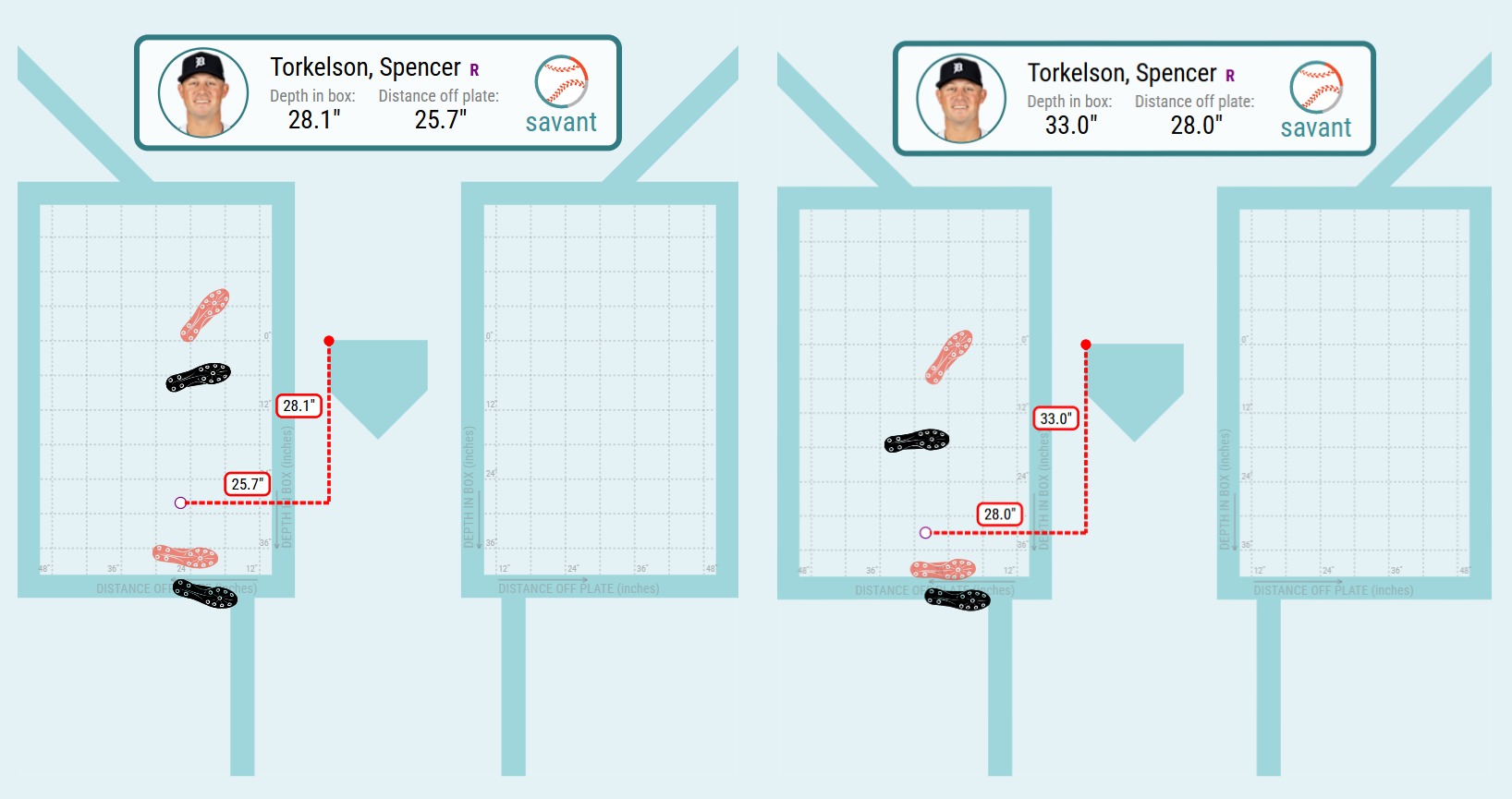When MLB.com senior club reporter Jason Beck outlined five questions facing the Tigers ahead of the offseason, he led with the most-pressing one: Where can Detroit upgrade its offense?
The story of the 2024 Tigers was one of “pitching chaos,” with Tarik Skubal and a cavalry of relief arms steering an improbable postseason berth. In order to take another step -- to build off last year’s miracle run -- the Tigers needed more from their offense. They had to score more runs.
Entering the final week of June, Detroit sits at 49-30, touting the best record in MLB. They have a commanding nine-game lead in the AL Central, looking like legit World Series contenders.
While the pitching has been stellar, the real story here is the offense, which has transformed from middling to a bona fide strength. At 4.90 runs per game, the Tigers boast the fifth-highest-scoring unit in baseball.
Detroit's offense, 2024 vs. '25
2024: .685 OPS (24th) and 95 wRC+ (23rd)
2025: .738 OPS (6th) and 109 wRC+ (8th)
It’s a complete top-to-bottom revival. Last year, 40.3% of all plate appearances by Tigers players were taken by average-or-better hitters (players with a wRC+ of 100 or better). This year, that figure has skyrocketed to 76.1%.
This isn’t a fluke, either: The Tigers have experienced some of the largest year-to-year improvements in quality of contact of any team.
Tigers' offensive improvements, '24 vs. '25
Lauch Angle sweet-spot rate: 34.3% to 37.5% (largest jump of any team)
xwOBA: .303 to .335 (second-largest)
Barrel rate: 7.6% to 10.2% (third-largest)
SLG: .385 to .416 (fourth-largest)
xSLG: .386 to .446 (fourth-largest)
It’s not as if the personnel has changed: This year’s group, a top-10 offense, largely resembles last year’s group that so often struggled to score. Detroit’s only significant offseason move was signing Gleyber Torres to a one-year deal, and Torres was coming off one of the worst years of his career in the Bronx. The moves -- or lack thereof -- didn’t exactly inspire confidence.
Instead, the Tigers bet on their internal development. Look at what president of baseball operations Scott Harris had to say last October, shortly after Detroit’s postseason run came to an end:
“Regardless of what we do in the offseason, the majority of our growth has to come from within,” Harris said on Oct. 14. “There are too many young players on this roster that can and must improve this offseason.”
Sure enough, that’s happened, and maybe to a degree that not even Harris anticipated. Let’s look at four of the Tigers’ most productive hitters -- by wRC+ -- and explore the changes that they’ve made en route to becoming key cogs in one of baseball’s best lineups.
All stats are through Saturday's games.
OF Riley Greene -- 141 wRC+
An All-Star last season, the 24-year-old Greene is a legitimate high-impact bat -- only six qualified hitters have posted a higher barrel rate (19.0%) in ‘25. He does it with elite bat speed and a sweet uppercut swing: At 45 degrees, his swing path (tilt) is the steepest in the Majors.
But the biggest difference for Greene this season has been an uptick in aggression.
Largest increase in swing rate, '24 to '25
174 qualifying hitters
- Christopher Morel (TB): +7.5%
- Dylan Moore (SEA): +7.1%
- Corbin Carroll (AZ): +6.8%
- Jackson Chourio (MIL): +6.7%
- Riley Greene (DET): +6.6% (44.3% to 50.9%)
“I’m just trying to make things happen instead of making things come to me,” Greene said at the beginning of June.
The new approach has come with a few side effects -- Greene wants to cut down on his strikeouts, and he’s chasing more often. But overall, it’s paying off: For one, he’s doing more damage against pitches in the strike zone, with a .340/.660 BA/SLG combo. These are pitches that he should be swinging at more often, and Statcast’s Run Value metric -- which grades every pitch based on its outcome -- validates Greene’s decision-making. He’s improved his Run Value on pitches in the strike zone by +15, from -14 to +1.
Only 14 hitters (min. 150 PA) have posted a higher Run Value on pitches in the strike zone than Greene. Pitchers are paying the price.
2B Gleyber Torres -- 134 wRC+
Detroit’s main offseason acquisition has a real chance to start the All-Star Game for the AL at second base. That’s because Torres again resembles the rookie who broke in with back-to-back All-Star appearances in 2018 and ‘19 with the Yankees.
While Torres has a solid .278/.419 BA/SLG combo, the expected stats are even more bullish. He ranks in the top-25 in xBA (.301) and xSLG (.528), while his xwOBA -- a metric that measures a hitter’s overall offensive performance, based on quality of contact and removing defense from the equation -- is in the 95th percentile, at .401.
In many ways, Torres has taken the opposite approach from Greene: He’s being more selective at the plate than ever before.
Improved discipline from Torres, '24 to '25 (percentile ranking)
- Strikeout rate: -8.4% (94th percentile of MLB)
- Swing rate: -6.2% (98th percentile)
- Whiff rate: -5.8% (87th percentile)
- Chase rate: -4.9% (99th percentile)
That's a pretty flawless formula: less chase, more contact, and more damage when contact is made.
INF/OF Javier Báez -- 123 wRC+
Few people had a resurgence from Báez on their bingo card, but his wRC+ in ‘25 (123) is higher than his total from the previous two years combined (106). His .516 OPS in ‘24 was the second-lowest in MLB, among hitters with at least 250 plate appearances.
These days, Báez looks like a different hitter: He’s moved nearly eight inches up in the box, and now only 11 qualified hitters have a shallower stance. As a result, he’s making contact, on average, 10.1 inches in front of the plate, one of the furthest intercept points in the Majors. You can see the changes below, with his '24 stance on the left and his '25 stance on the right; the red cleats outline his position at bat-ball intercept, with the black cleats showing his original batting stance.

In April, Báez stressed the importance of working on his timing. This is a lot about what does and doesn’t work for a hitter, and with a new stance, perhaps Báez unlocked something.
What’s especially interesting here is the way that Báez, a notorious free-swinger, is being pitched.
His in-zone rate -- the percentage of pitches that a batter sees within the strike zone -- is 48.7%, which would be the highest single-season rate of his career. In fact, in June, 52.3% of the pitches that he’s seen have been strikes. That’s the highest single-month rate of his entire career.

This is odd, and it may be partially due to some slight adjustments on Báez's part. His chase rate (40.6%) is still well above league average, but it’s also the second-lowest single-season mark of his career. His whiff rate (28.1%) is the lowest it’s ever been. Reducing those habits, even slightly, seems to be forcing pitchers to come into the zone more often, helping Báez do consistent damage.
1B Spencer Torkelson -- 121 wRC+
The first overall pick in the 2020 MLB Draft, Torkelson arrived at Spring Training without a job, only to force his way onto the roster -- and into a starting spot. He’s hitting like the player who bashed 31 home runs in ‘23, even though, in the box, he looks entirely different: His stance is more open and narrower, while he’s standing further back in the box.

A lot of these changes simply come down to feel -- Torkelson has repeatedly said that his new stance makes him feel “more athletic” in the box. And that’s unlocked a new level.
“I think naturally, since I can remember picking up a wiffle ball bat, I love getting the ball in the air and that’s what I do,” Torkelson told the Detroit Free Press in April. “And so now, I am in a position to do that without thinking about it.”
What he’s talking about, in part, is his attack angle -- the vertical angle that the bat is moving at impact with the ball. It’s largely a timing metric, and there’s a strong correlation between a hitter’s attack angle and their ability to hit the ball in the air. The average attack angle is 10°; over the last year, Torkelson has increased his attack angle from 11° to 14°.
Sure enough, he’s slashed his ground ball rate, but more importantly, he’s pulling the ball in the air at a much higher clip this year (30.7%) than last year (24.4%), making the sort of contact most advantageous for a hitter. In turn, he’s doubled his barrel rate and experienced the fourth-largest increase in xSLG, behind only Corbin Carroll, Pete Alonso, and Pete Crow-Armstrong.
His timing has changed -- we can see that through his performance against fastballs, in particular. His .266/.489 BA/SLG combo is out-pacing the .223/.380 marks he posted in 2024.
Detroit's lineup renaissance goes beyond these four hitters. But Greene, Torres, Báez, and Torkelson have made significant strides, keying a legitimately dangerous lineup. Unlike last season, the Tigers bring far more to the table than a strong pitching staff.
